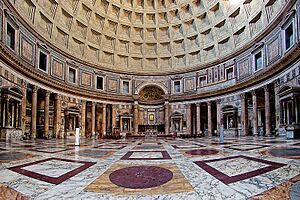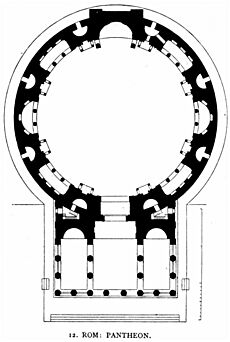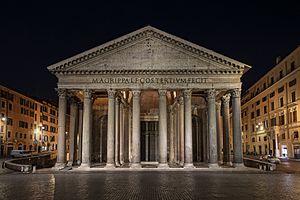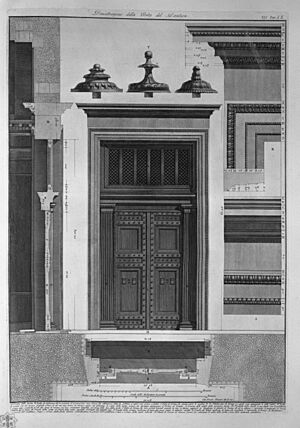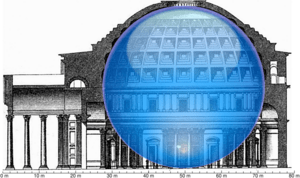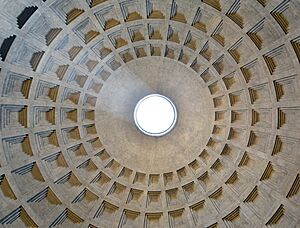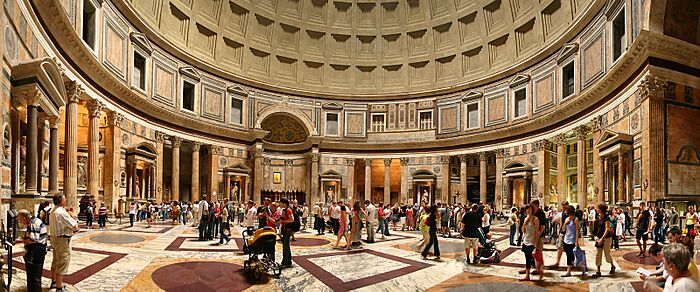Pantheon, Rome facts for kids
Quick facts for kids Pantheon |
|
|---|---|
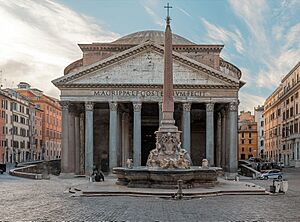
Facade of the Pantheon, with the Pantheon obelisk
|
|
| Religion | |
| Affiliation | Catholicism (since 609) Ancient Roman religion (formerly) |
| Ecclesiastical or organizational status | Minor basilica, Rectory church Roman temple (formerly) |
| Leadership | Msgr. Daniele Micheletti |
| Year consecrated | 13 May 609 |
| Location | |
| Location | Rome, Italy |
| Architecture | |
| Architectural style | Roman |
| Completed | 126 |
| Specifications | |
| Direction of façade | North |
| Length | 84 metres (276 ft) |
| Width | 58 metres (190 ft) |
| Height (max) | 58 metres (190 ft) |
| Website | |
| Official website: https://web.archive.org/web/20150916002619/http://www.vicariatusurbis.org/SantaMariaadMartyres/ | |
The Pantheon is an amazing ancient building in Rome, Italy. It was built almost 2,000 years ago! It started as a Roman temple dedicated to all the gods. But since the year 609 AD, it has been a Catholic church. Its official church name is the Basilica of St. Mary and the Martyrs.
The Pantheon is famous for its round shape and its huge dome. It's one of the best-preserved ancient Roman buildings. This is because it has been used continuously throughout history. Today, it's a popular place for visitors. Millions of people come to see it every year.
Contents
What's in a Name?
The name "Pantheon" comes from an ancient Greek word, "Pantheion." This word means "of all the gods." The simplest idea is that it was a temple for all the Roman gods.
Some ancient writers, like Cassius Dio, thought the name came from the many statues of gods inside. He also thought the dome looked like the heavens. This shows that even long ago, people wondered about the building's name.
Over time, the word "pantheon" has also come to mean a building where famous people are honored or buried. For example, there's a famous Panthéon in Paris, France.
A Look Back in Time
The Pantheon you see today isn't the very first one. It was built on the site of an older temple.
The First Pantheon
The first Pantheon was ordered by a Roman general named Marcus Vipsanius Agrippa. He was a friend of Emperor Augustus. Agrippa's building was finished around 27 BC. It was part of a big building project he had in Rome.
Sadly, this first Pantheon was damaged by fire.
Rebuilding by Hadrian
After the first building was destroyed by fire, the Emperor Hadrian ordered a new one to be built. This is the Pantheon we see today. It was probably finished around 126 AD.
Hadrian chose to put Agrippa's original inscription on the front of the new temple. This inscription says: "Marcus Agrippa, son of Lucius, made [this building] when consul for the third time." This was a common practice for Hadrian. He often honored the original builders when he rebuilt structures.
From Temple to Church
In 609 AD, a Byzantine emperor named Phocas gave the Pantheon to Pope Boniface IV. The Pope then turned it into a Christian church. He dedicated it to St. Mary and all the martyrs. This is why it's also called the Basilica of St. Mary and the Martyrs.
Turning it into a church helped save the Pantheon. Many other ancient Roman buildings were destroyed or fell apart over time. But because the Pantheon was used as a church, it was cared for and preserved.
Changes Over the Years
Even though it was saved, the Pantheon still saw some changes. In 663 AD, Emperor Constans II visited Rome. He took the bronze tiles from the Pantheon's roof. He sent them to Constantinople.
Later, in the 1600s, Pope Urban VIII ordered the bronze ceiling from the front porch to be melted down. Most of this bronze was used to make cannons for a nearby castle. People joked about this, saying, "What the barbarians did not do, the Barberinis [Urban VIII's family] did!"
In the 1800s, two kings of Italy were buried in the Pantheon: King Vittorio Emanuele II and King Umberto I. Umberto's wife, Queen Margherita, is also buried there.
Today, the Pantheon is still an active Catholic church. Masses are held there on Sundays and special holidays.
How It's Built
The Pantheon is an amazing example of Roman engineering.
The Front Porch
The front of the Pantheon has a large porch, called a portico. It has huge granite columns. These columns are very tall, about 11.9 meters (39 feet) high! They were brought all the way from quarries in Egypt. Imagine how hard it was to move such massive stones!
The front of the porch used to have sculptures, probably made of gilded bronze. The large bronze doors leading into the main part of the building are also very old. They are believed to be the original Roman doors, which is very rare.
The Big Round Room
The main part of the Pantheon is a huge round room called the rotunda. It's covered by a massive concrete dome. This dome is still the largest unreinforced concrete dome in the world! That means it doesn't have steel bars inside to make it stronger, like modern concrete.
The dome is very thick at its base, about 6.4 meters (21 feet). But it gets thinner towards the top, only about 1.2 meters (4 feet) thick around the central opening. The Romans used lighter stones, like pumice, in the upper parts of the dome to make it less heavy.
The Oculus
At the very top of the dome is a large circular opening called the oculus. It's about 9.1 meters (30 feet) wide. The oculus is the only source of natural light inside the Pantheon. Rain also comes through it, but the floor has drains and is slightly sloped to let the water run off.
The height of the oculus from the floor and the diameter of the rotunda are exactly the same: 43.3 meters (142 feet). This means a perfect sphere could fit inside the Pantheon!
The inside of the dome has sunken panels called coffers. There are five rings of 28 coffers. In ancient times, these coffers might have held bronze rosettes, making the dome look like a starry sky.
Inside the Pantheon
When you step inside, you'll see the huge round room and the dome above. The light from the oculus moves around the space throughout the day, like a giant sundial.
The floor has a checkerboard pattern, which looks cool with the circular patterns of the dome.
Religious Art and Tombs
Since it became a church, the Pantheon has many Christian artworks and altars. The main altar has an old Byzantine painting of the Virgin Mary and Child.
Many famous people are buried here. One of the most well-known is the painter Raphael, who died in 1520. His tomb has a famous inscription that means: "Here lies Raphael, by whom the great mother of all things (Nature) feared to be overcome while he was living, and while he was dying, herself to die."
As mentioned before, two Italian kings, Victor Emmanuel II and Umberto I, are also buried here. Their tombs are guarded by a special group called the National Institute of Honour Guards.
A Building That Inspired Others
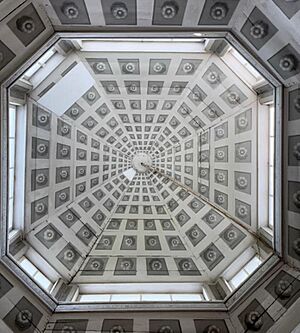
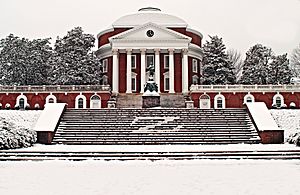
The Pantheon has been a huge inspiration for architects for centuries. Its design, with a grand porch and a large dome, has been copied many times.
One of the first to be inspired was Filippo Brunelleschi. He studied the Pantheon when he designed the famous dome of the Florence Cathedral in Italy, completed in 1436.
Many other famous buildings around the world have been influenced by the Pantheon. These include:
- The Santa Maria Assunta church in Italy.
- The Rotunda of Mosta in Malta.
- The Low Memorial Library at Columbia University in New York City.
- The Rotunda at the University of Virginia, designed by Thomas Jefferson.
The Pantheon truly is a masterpiece that continues to amaze and inspire people around the globe.
Images for kids
-
The dome photographed with a fisheye lens in 2016
-
Tomb of King Victor Emmanuel II, "Father of the Country"
-
The icon of the Madonna which was given by Phocas to Pope Boniface IV
See also
 In Spanish: Panteón de Agripa para niños
In Spanish: Panteón de Agripa para niños


